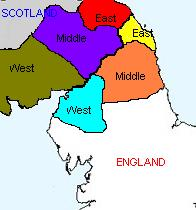Marches
Marches served as border-guards. They protected the main-land from the adjacent country.
Throughout Henry VIII’s reign, this was primarily the Scottish.
Palatinates
Palatinates were the countries of Lancaster, Durham and Chester.
Their rulers had extensive powers and often challenged royal authority.
Regional Variations
Transclude of Annotated-Tudors-Map---Regional-Variations.excalidraw
Wales
- Separate entity to England prior to 1536
- Did not have a unified leadership or political link with England
- Joined by Laws in Act of 1536
- Divided Wales into shire counties - operated on the same basis as England
- Gave Welsh shires direct representation in Parliament (House of Commons)
- Brought Wales into the same legal framework as England
- Partially lost identity after joining but retained certain parts, e.g., Welsh language
Border & Marches
The Welsh border was easy to police and maintain, being relatively cheap.
The lands were governed as part of the Principality of Wales, alongside the four bordering English counties:
- Shropshire
- Herefordshire
- Worcester
- Gloucester
The area was under the jurisdiction of the Council of Wales and the Marches.
The Marches were based in Ludlow, Shropshire, which offered cheap and local access to law.
Scotland
Border
The border between Scotland and England was long problematic, being difficult to police due to various reasons. Most of it was remote and inhabitable in winter months.
Both sides of the border had a reputation for lawlessness.
Marches
Both English and Scottish marches were split into three segments:
- East
- West
- Middle

This helped manage the border and enforce law. Each jurisdiction was under a warden; a difficult position to fulfil due to the risk of exploitation.
The decision to appoint either local nobles (personal exploitation) or gentry (external exploitation, little influence - loyalty to the king, not them) both ran huge risks.